When Neve at Search Press got in touch to ask if I might like a review copy of Kim Tillyer’s new book Beginner’s Guide to Cyanotype it was one of those rare, almost spooky coincidences. I had literally been researching a project about women makers that morning and found myself really caught up in the story of Victorian illustrator Anna Atkins and her Prussian Blue and white cyanotype images of British Algae.
Atkins was the first person to illustrate a book with photographic images but her work was largely overlooked until fairly recently. There is an ethereal, almost magical, feel to the way Atkins captured images of her subject, all in the most beautiful shades of ocean blue. My research took me from The Natural History Museum to an archive of Atkins’ original book Photographs of British Algae Volume 1 on through Kew Gardens and The V&A and, somehow or other, to Instagram and Kim Tillyer an artist and illustrator based in the Lake District who incorporates cyanotype into her work. She had me at: ‘I’ve been awake since 4am and have absolutely no idea what to write, here is a row of blue and white lanterns in the low winter light.

I’d tried listening to a podcast (Fortunately with Jane Garvey and Fi Glover) to help me go back to sleep but bits of it were so funny that it woke me up even more with giggling and by 7am I’d given up and was eating toast in my polar bear suit, cuddling a hot water bottle.’
‘She sounds like my kind of person,’ I thought.
Then I discovered Kim’s work. There’s something almost achingly beautiful about the way she combines ethereal print making and story telling, often with hand stitched detail. I really love this A Secret Garden original cyanotype print with hand embroidery in metallic thread currently available to buy in her online shop.

When an artist or maker resonates with me like that, I make a mental note to get in touch. I didn’t need the mental note, because that same day I received the email from the publishers of Kim’s new book. A book all about the intriguing creative process I’d literally just discovered – written by that one particular artist who’d caught my eye.
I replied with what I now realise was probably unseemly haste to say I’d be delighted to receive a review copy of Beginner’s Guide to Cyanotype. Since then, this beautiful book has sat beside my bed and I have absolutely loved browsing through, reading up about the subject and planning which of the projects to try my hand at first. I’d love you to discover the joys of this book too.
I’m delighted to have four signed copies of Beginner’s Guide to Cyanotype to be won – scroll down to the end of this feature for details on how to enter. Kim has also shared a tutorial from the book – how to make a cyanotype purse with trompe l’oeil lace print pattern to give you a taste for free https://www.frombritainwithlove.com/how-to-make-a-cyanotype-purse-with-trompe-loeil-lace-print/.
Here’s a peek inside Beginner’s Guide to Cyanotype and a Q&A feature with Kim herself. I hope you enjoy ‘meeting’ her as much as I did! And don’t forget that we have four signed copies to be won – just scroll down to the bottom of this post to find out how to enter – it’s really easy!
Beginner’s Guide to Cyantotype by Kim Tillyer: a peek inside:
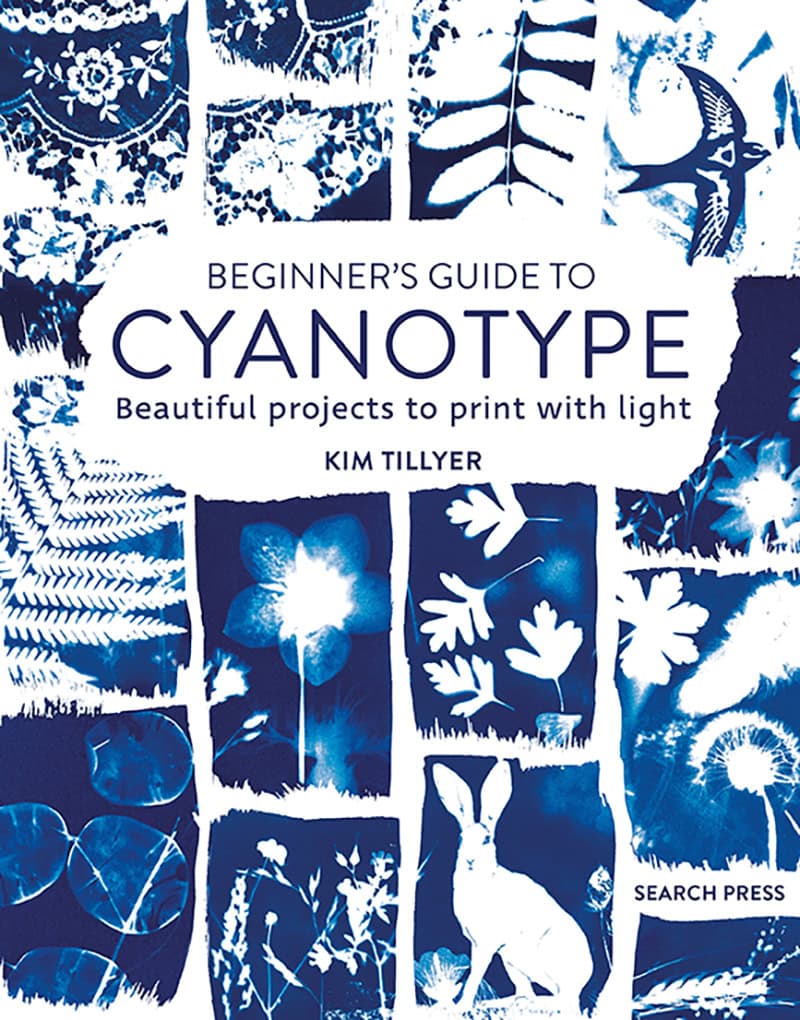
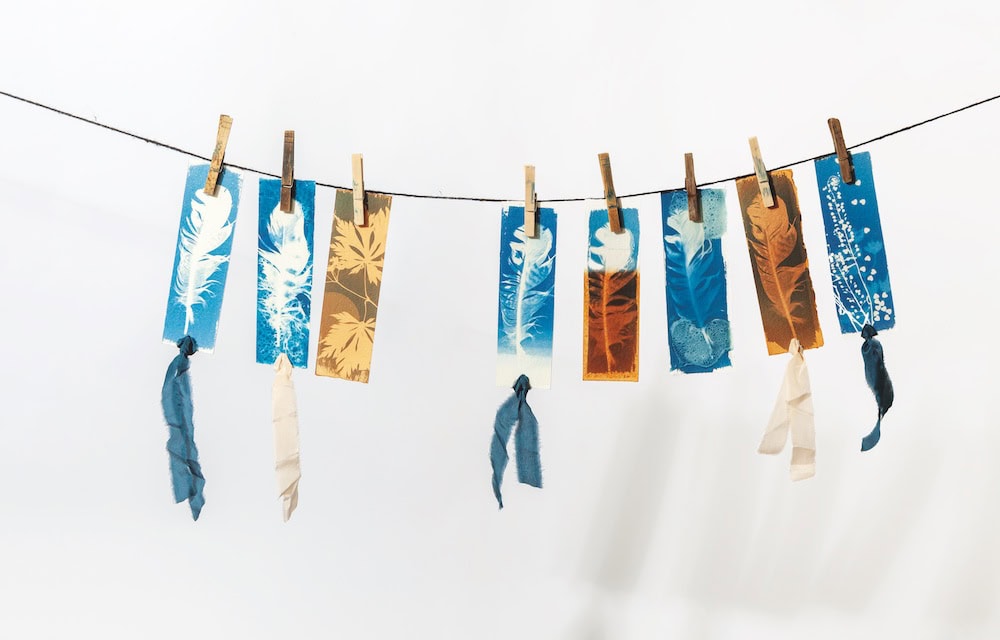


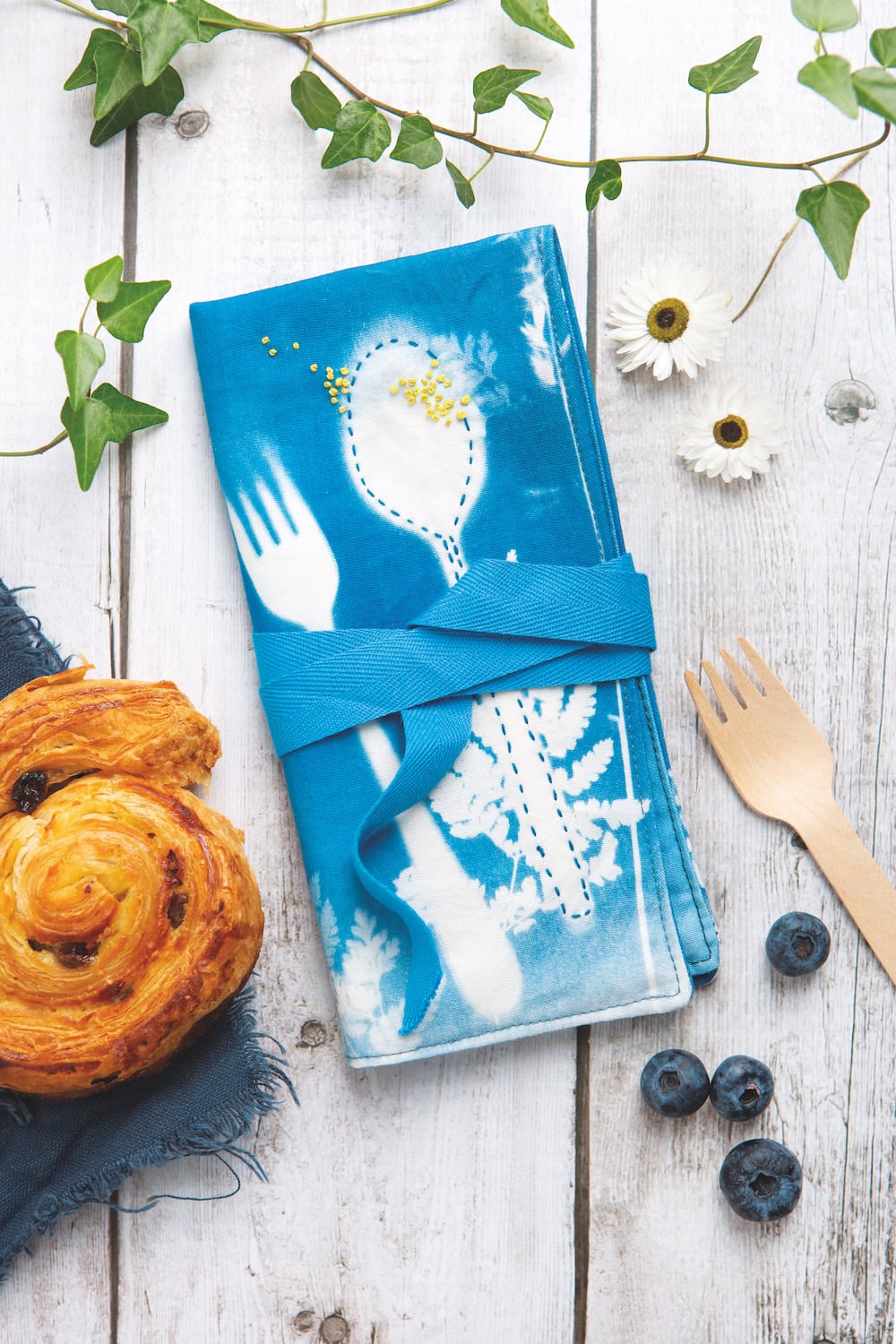
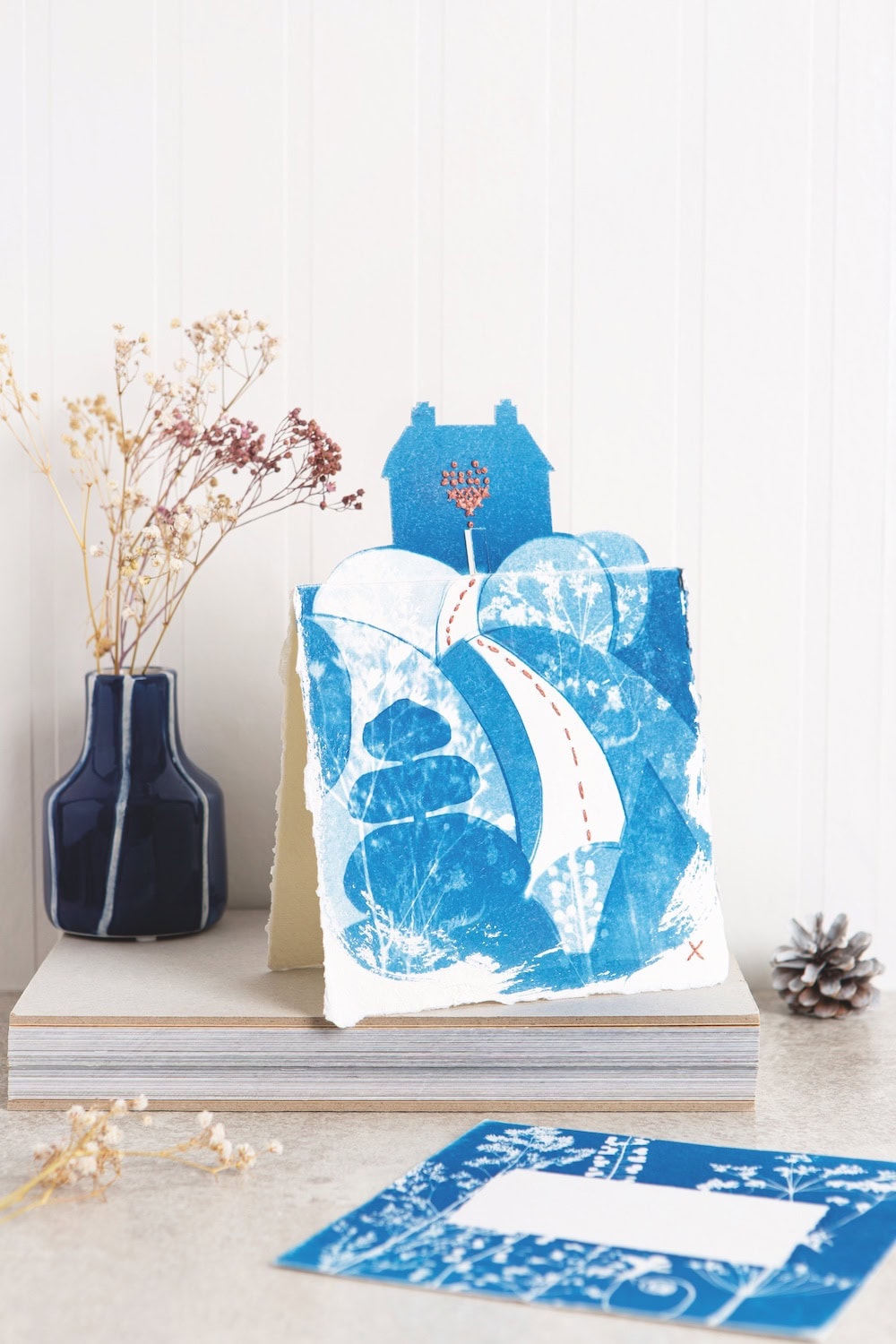


I know how many of you are permanently hungry for new creative ideas to inspire you, so I thought that Beginner’s Guide to Cyanotype might hit the spot. This book does exactly what it promises and is the perfect beginner’s guide to the subject. If (like I was) you’re somewhat daunted to read about the chemicals and science involved, don’t be. Kim is very reassuring about how easy and inexpensive it is to simply have a go. To make life really easy, Kim has also put together some great little cyanotype kits which you can buy from her online shop. See if this magical blue art form grabs you the way it did Kim – and Anna Atkins centuries before her.
Armed with Kim’s expert guide to getting started, you can either bring your own ideas to life, follow one of the really lovely DIY tutorials in the book or maybe a combination of the two. The projects featured include a truly lovely nature journal, tote bag, light shade, greetings card, trompe l’oeil purse and more. All are really beautiful and simple to make. Kim has kindly shared her step by step tutorial to make a pretty Trompe L’Oeil cyanotype purse with FBWL readers if you fancy clicking through and having a go: https://www.frombritainwithlove.com/how-to-make-a-cyanotype-purse-with-trompe-loeil-lace-print/
Q&A with Kim
What inspired you to write your book Beginner’s Guide to Cyanotype and what is your writing/creative process?
At the time when I first started making cyanotypes there weren’t many books around on the subject, at least not easily available and affordable. I work in a bookshop and it was something we’d noticed so I had been toying with the idea of writing a simple guide to explain my art process when Search Press approached me out of the blue.
I’ve always enjoyed writing, I’ve kept a blog on and off since 2008, so I found that bit quite easy. It was harder to decide on which projects to include and get them to work every time!
Can you explain in simple terms what the process is?
Cyanotype is a printing process developed at the same time as photography was being invented. Prints are made using a light sensitive emulsion which changes colour when exposed to UV light. Prussion Blue is the result and so this is where we get the term “blueprint” from as it was used to make accurate reproductions of technical drawings.
How/when did you become interested in the history of cyanotype and particularly the overlooked women doing great work in this and related fields (such as Anna Atkins). What are your thoughts on the women pioneers in creative fields in general and cyanotype specifically?
The era in which cyanotype was invented was such an interesting time for scientific discovery and the observation of the natural world. Things were changing fast (a bit like now with AI and other technologies) and we now know that women were part of that but not always credited for the part they played. Anna Atkins is a great example of a woman who was encouraged to create and explore by her enlightened father, building on the work of the scientific men around her but undoubtedly restricted by her sex and relatively unrecognised until fairly recently. Beatrix Potter is another example of an artist whose scientific work was rejected or hindered by social norms and what was expected of women (in 1997, the Linnaean Society even offered her a posthumous apology). We’ve come a long way but even when my daughter was at school the timetable choice was between Science or Art!
It sounds like when you set out on your own cyanotype journey back in 2008 that you were also somewhat of a pioneer given how little information there was then – and how hard it was to get the materials etc. Can you talk us through this story a little and what drove/drives you?
I would never call myself a pioneer! In 2008 I lived in the middle of nowhere with a very very poor dial up internet connection so possibly I was just in a blissful bubble! I had studied textiles for my degree and wanted to print my drawings onto fabric without access to screen printing or digital printing. So I managed to discover fellow Yorkshire woman, Ruth Brown of Stone Creek Textiles who at the time was making cyanotypes, selling the chemicals and had written a really great book “Cyanotypes on Fabric” https://amzn.to/3XzSa4q which got me started.
Was there a moment when you knew you were ‘hooked’ on cyanotype and can you describe it? What is it that particularly appeals to you about the process?
I think the thing with cyanotype is the unpredictability of it, at least in my experience. You could make a simple leaf print twice using the same leaf, paper and solution but get different results each time. It is beautifully analogue in an age of glossy digital media and it is accessible to everyone from school kids to fine artists. You can work tiny or HUGE, use natural forms or man-made items, photographs, drawings or mark making and the alchemy as the image emerges is always a little bit magical.
Can you talk us through your creative cyanotype process? Where/how do your design ideas start and how do you progress them?

I work in a fairly haphazard way and things often work by accident. So, writing step by step instructions and trying to give definitive answers in a book wasn’t easy! I like to use images that I’ve drawn myself. I’m interested in the image not just the process, so I tend to use a sketchbook and then take elements from my drawings into Photoshop so that I can make a digital negative, printed onto acetate. I sometimes stitch into finished prints to add texture and contrasting colour.

How would you describe your design style?
That’s a tricky one… my work is very illustrative which can be seen as the poor relation of “fine art” or conceptual art but I love books and stories, myths and legends so that’s fine by me – ethereal storytelling.

What do you hope the book gives to your readers?
I really hope that people who have not done anything creative for a while or who have got stuck in a rut, might decide to give it a go because anyone can get lovely results very quickly. Because I am an artist and illustrator I also hope that people might buy it just because it looks beautiful.
For anyone interested in trying cyanotype, can you suggest a good place to start? Anything to avoid when starting out?
A while ago I went on a lovely basket making workshop and was excited to get all the stuff and make more. I bought a gorgeous book but felt nervous about buying the tools and materials as it seemed quite complicated – like all new things. So, my advice is – read the book and start off with a simple kit that has everything you need in it. I make kits to sell but this week I’ve also been using one from cyanotype.co.uk which is so easy to use and a great place to start. You can even get pre-coated fabric and paper.
Can you describe a perfect day in your studio and where the creative joy lies for you?

The perfect day for me starts late, involves a lot of coffee and snacks, a good audiobook and is busy with a mix of routine tasks (packing orders, folding cards etc.) and new ideas. Artists and writers talk about “the flow” and once I get swept along in it it’s really frustrating to have to stop. You can guarantee it happens at about midnight when I have bookshop work the next day! I read somewhere that the writer and illustrator Judith Kerr always left her studio in the evening with something simple to complete in the morning which I think is my ideal – nothing worse than a creative struggle before coffee time!
Recently I’ve been working on pieces inspired by the barrel pond I made when we moved here, using a combination of collagraph and cyanotype


Are there other cyanotype artists that inspire you? Who are they and what do you like about them?
I’ve always tried to avoid looking at other artists working with cyanotype, mainly because it’s so hard to stand out in a sea of blue and white. I never want to be accused of copying an idea and also because I’m easily discouraged and nervous of comparison. However, Jo Howell, from Sunderland, was really helpful when I was writing the book because she does a lot of printing on surfaces like glass and ceramic. Angela Chalmers, from Scarborough is someone I know in real life and her work, often large scale, is really beautiful.

As a child, what did you want to be when you grew up? What are your early creative memories?
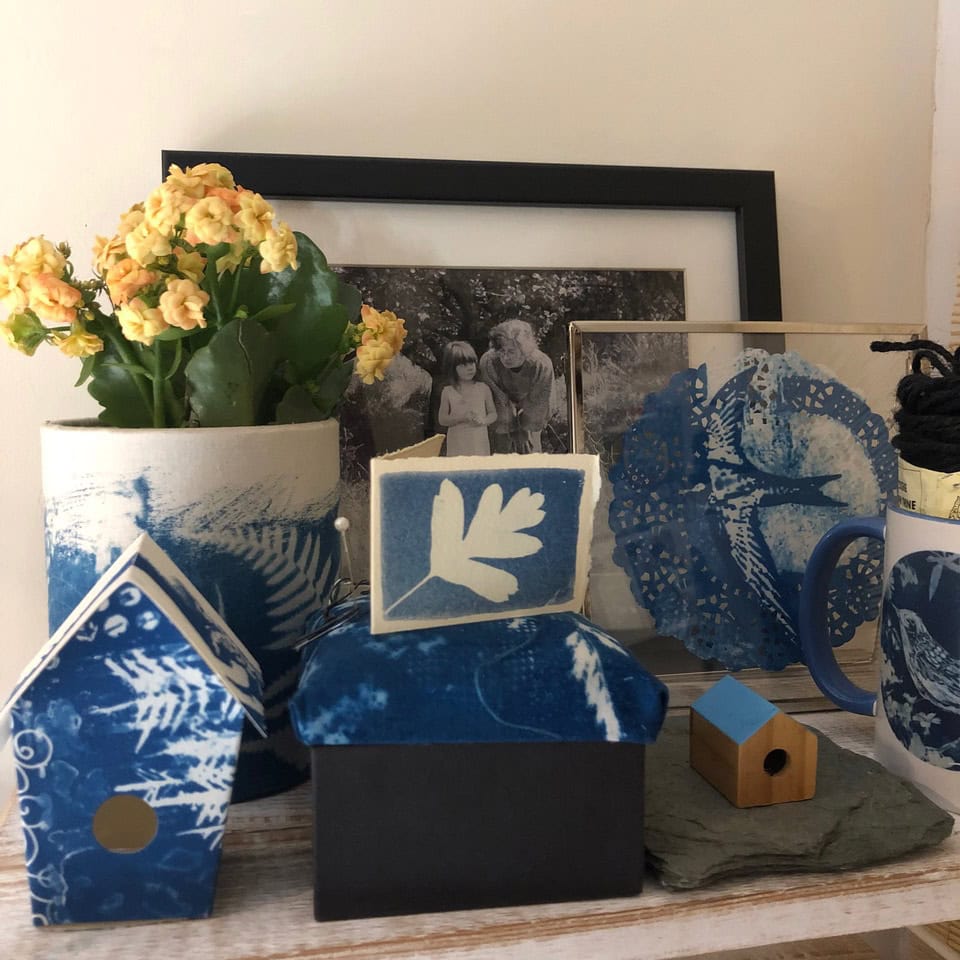
I wanted to be a horse or Sherlock Holmes or possibly a member of Abba as a small child. I never had any burning desire to be An Artist because there already was one of those in the family! (my dad is the painter William Tillyer). Both my parents are very creative and there were always art materials around but I was never pushed in that direction.
What are your top tips for enabling creativity/wellbeing?
I do think about this a lot but never take my own advice! I think that for all of the real connections it can build, being online can be a nightmare of comparison and imposter syndrome so I would definitely say, spend time with real people, be outside in nature and keep playing.
What do you do when struggling for creativity/inspiration?
If I’m honest I eat a lot of toast, bake bread, wander around in the garden, spend too much time online and look hopelessly out of the window sighing a lot! I should know by now that inspiration will come eventually, usually in the evenings after a walk and only if I pretend I’m not looking for it. But I’m very hard on myself. I always think inspiration for me is like looking at stars: some of them can only be seen if you look don’t look at them directly.
Favourite season and why?
I like the bits in between seasons when you can feel change in the air (which is odd because I don’t really like change). Winter when I lived in Yorkshire was a special time for me. I do like a bit of rural hygge – firelight and frost, getting snowed in with just a fruitcake and a sketchbook…
Most treasured possession and why?
Impossible question! I’m so sentimental I can’t even delete text messages from my family because EVERYTHING is treasured. Perhaps I could choose the etching my dad made when my mum was pregnant with me, it’s called The Masterpiece and I’m still waiting/hoping to live up to that expectation!
Where in the UK are, you based and what do you like about where you live?

I’ve lived in the Lake District since 2015, unlike most people who come here it wasn’t totally through choice (I’d been very traumatically evicted from the house I’d rented with my young family for nearly 15 years in North Yorkshire).

We’ve moved twice since then but my partner and I now rent a lovely place with a very pink garden and a perfect little studio space, it’s the most settled I’ve felt for years but my heart still belongs to the North York Moors.
Favourite book of all time and why?

I work in a bookshop and read a lot so this is another hard question, however, Moominland Midwinter which I first read one snowed in winter on the moors, when I was about 40 is very special to me.
How to win a signed copy of the book

How to enter
We have four signed copies of Beginner’s Guide to Cyanotype to be won. So why not enter now? All you have to do is share your own thoughts on cyanotype and where you hope this book might take you. Be as creative as you like!
Post your entry as a comment at the foot of this blog post in the Leave a Reply box below. (You need to enter your name and email before commenting, but your email address won’t appear on the front end. You can ignore the box asking for your website, but feel free to add one if you’d like to!).
After clicking the Post Comment button, you will see a message saying ‘awaiting moderation’ and your entry won’t yet be visible to other users. It will come through to our admin area and once we’ve logged your entry we’ll publish it.
Please note that this competition is only open to residents of the UK.
Good luck and hope you enjoy! We’ll be choosing the winners of the four signed copies of Beginner’s Guide to Cyanotype at the end of August.
INFORMATION
Kim has put together some great Cyanotype kits which you can buy from her online shop: https://witchmountain.co.uk/gifts/cyanotypekit
Beginner’s Guide to Cyanotype is published by Search Press and available from all good bookshops as well as Amazon.
This article contains some affiliate links, which means we may earn a small commission if a reader clicks through and makes a purchase. All our blog posts are independent and in no way influenced by any advertiser or commercial initiative. By clicking on an affiliate link, you accept that third-party cookies will be set.




 .
.
.
.
.
.
#capturequiet #ins
.
.
.
.
.
.
#capturequiet #ins








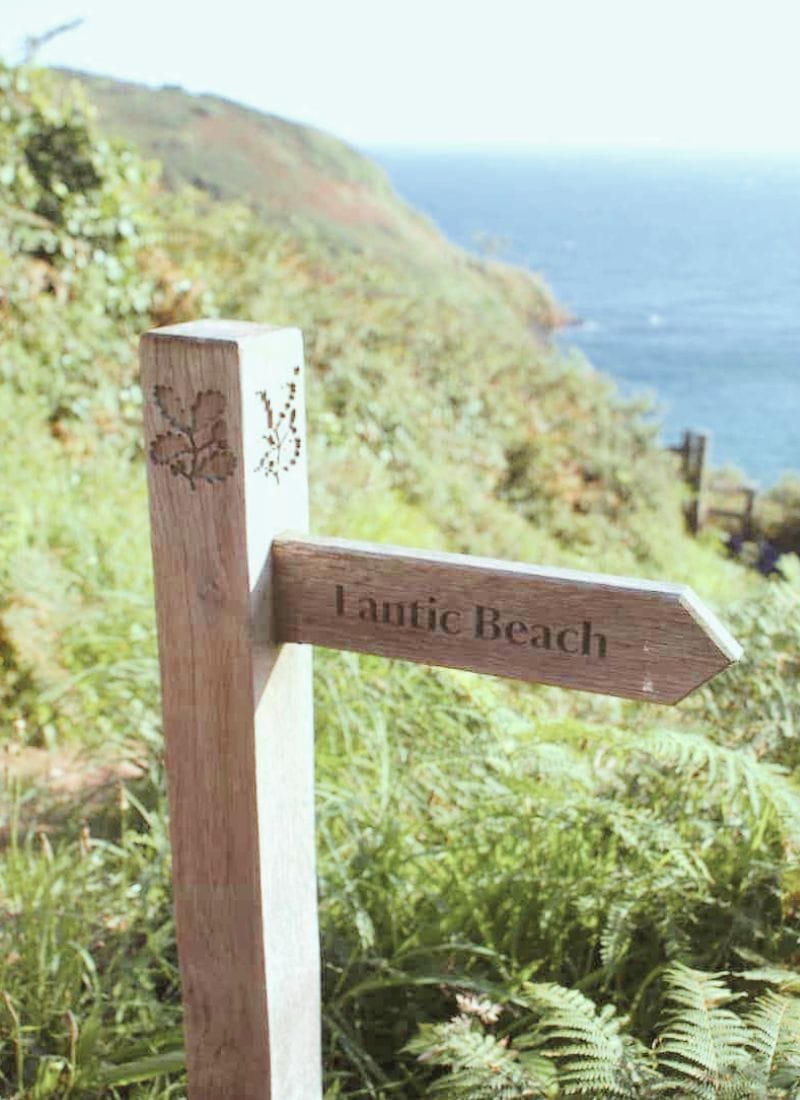

 I think what’s put me off trying it before has been the idea of expense and how to do it. Reading this interview was inspiring and made me realise that it could be doable.
I think what’s put me off trying it before has been the idea of expense and how to do it. Reading this interview was inspiring and made me realise that it could be doable.













Leave a Reply